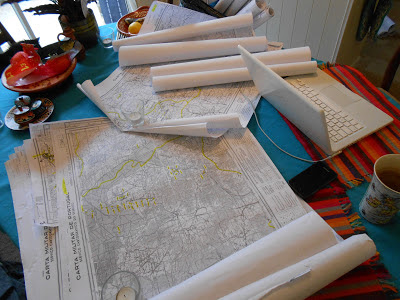 |
| Gorgeous blue Roller feather samples plus cleaning chemicals |
I use stable
isotopes of Hydrogen, Carbon and Nitrogen from feathers and claws to determine
if a bird wintered in Iberia or Africa. This is the bit of my research that
non-scientists least understand, so how does it work?
In a
nutshell a stable isotope is one of 2 or more naturally occurring forms of the
same element. They demonstrate the same chemical properties and vary only in
the number of neutrons in the nucleus. This means the only difference between
them is a slight variation in weight. They are stable because they do not decay
over time like radioactive isotopes. In food webs the heavier isotope is
usually less common than the lighter form and I measure these tiny differences
in weight ratios in a mass spectrometer.
 |
| Samples are weighed out into tin capsules and folded very small |
Fractionation. Various naturally
occurring biochemical processes (eg rainwater evaporation, body metabolism) alter
the ratios of stable isotopes at the base of the food chain (fractionation) and
these isotopic signatures are taken up by all species through diet and drinking
water and become permanently fixed in hair, nails and feathers after growth. This
means the stable isotope ratios in my feathers and claw samples reflect the
values in the local food web where they were grown and are unchanged when a
bird migrates to a new, isotopically distinct location. From this inferences
can be made about the location where the feathers were grown.
My Analysis. At the
moment I am simultaneously analysing Carbon (13C/12C) and Nitrogen (15N/14N) -expect
a blog about Hydrogen (2H/1H) later. Nitrogen is used to distinguish trophic
position in the food chain and to detect changes between marine and freshwater
diets; not so applicable for my birds so I am more interested in Carbon.
 |
| The 2 furnaces for the mass spectrometer. The red 'Vecstar' furnace for C/N next to the 'Costech' furnace used for H |
Forensic Ecology. Carbon isotopic
ratios indicate what sort of habitat the feather/nail was grown. This is
because C3 and C4/CAM photosynthetic pathway plants
fractionate Carbon isotopes differently by each using a different enzyme to
grab CO2 out of the air at the first step of photosynthesis. Most temperate
latitude plants are C3 pathway species (eg wheat, potatoes). C4 plants (eg
sugarcane) dominate in tropical and subtropical latitudes and have higher d13C
ratios than C3 pathway plants. This means I can tell what sort of plan life was
at the base of the food chain where the feather was grown and this helps me
decide whether the bird spent the winter in a temperate or (sub)tropical region.
It is all pretty
amazing! –but not without various problems in data interpretation which I am
sure I shall go in to (read: rant about) at some point!
 |
| The output screen: 2 square peaks of reference gas, then a small Nitrogen peak. The jump to Carbon (more visible as a line in the top graph) then a taller Carbon peak and 2 square reference peaks -the second just being produced. The Carbon peak is taller because feathers contain more Carbon than Nitrogen. |













